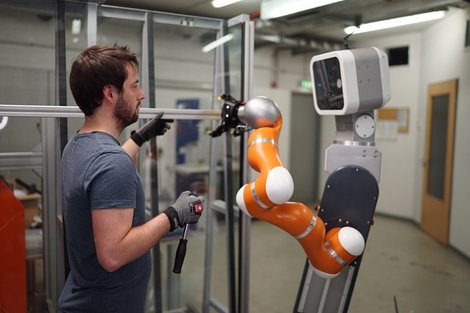Human–Robot collaboration – future scenarios from Saxony-Anhalt

Dr.-Ing. Sonja Schmicker: “The best technology is worthless if it is never used.”
When it comes to digitalisation and Industry 4.0, it so often seems that it’s all about the technology. Digital intelligence is growing. Innovative technologies, machines and robots are taking on increasingly complex tasks. But even the most exciting future scenarios will not be able to get by entirely without humans, as impressive new projects and studies from Saxony-Anhalt show.
Fifty years of research for the working world of tomorrow
For more than fifty years now, scientists and students of Otto von Guericke University in Magdeburg have been contemplating how the working world will change and how it can be shaped. Founded in 1965, the Chair of Human Factors Engineering at the Institute of Ergonomics, Manufacturing Systems and Automation (IAF), is in higher demand than ever. “Digitalisation concerns all areas of society,” says Head of Chair Dr.-Ing. Sonja Schmicker. “The high dynamism and increasing complexity of work processes are presenting major challenges in research and practice.” That means it is more necessary than ever to build acceptance of new technologies in order to overcome the distances between man and robot, Schmicker asserts. “The best technology is worthless if it is never used.”
This very matter is being tackled in futureTEX*, a research project in which the key role of man has been integrated since the very beginning. The aim of this project, which is part of in the federal programme “Zwanzig20 – Partnerschaft für Innovation”, is to develop a future-oriented textile industry in Germany focussing on technical textiles that require special R&D know-how. For its part, the IAF has analysed the requirements of future work processes and developed new work systems, complemented by learning-supportive smart devices.
The ego.-INCUBATOR* “AWI-LAB”, an ergonomics lab for the promotion of start-ups in the “Innovative Working World 4.0”, was established at the Chair in 2017 to learn what is involved in creating a start-up-oriented ergonomic infrastructure. Experts from the Chair actively support students and young graduates of all specialisations in the conception and real-world testing of their ideas for founding new companies. Primary interest is given to devising digital work systems for what the Saxony-Anhalt state government has identified as the lead markets, namely “Energy, Plant Engineering and Construction, Resource Efficiency, and Health and Medicine”.
The interdisciplinary project ArdiAS*, managed by the affiliated institute METOP GmbH, aims to promote healthy mobile working in the technical service sector. Design solutions are being developed in the form of digital assistance systems – without limitation of tactile capabilities – for the physical and psychological relief of service technicians in settings such as wind farms.
Human–robot collaboration: successful through safety
The Fraunhofer Institute for Factory Operation and Automation IFF in Magdeburg is a world leading research institute for assistance robotics, one of the key disciplines of Industry 4.0. One essential issue for the usability and acceptance of robot assistants is safety. “For example, we are developing new sensory methods for detecting people in the vicinity of the robot,” says Prof. Dr. techn. Norbert Elkmann, who heads the Robotics Systems business unit. “That way we ensure there is no danger to people in the human-robot collaboration.”
At the end of last year, a comprehensive and world premiere volunteer study* was concluded that had studied, for the first time, the load limits involved in the contact between man and robot. From thousands of tests using special setups to measure the point of onset of pain or injury, a value table was derived that will be of enormous value for future standardisation. Furthermore, these data will form the basis for reliable simulations of complex production processes that involve contact situations.
Two more projects that have helped to increase safety in the use of robots are FourByThree* and SAPARO*. The project FourByThree made advancements and implemented solutions in the optical workspace monitoring of human–robot collaboration workplaces. Product development is currently underway in cooperation with a renowned industrial partner. In the project SAPARO, pressure-sensitive, tactile floor coverings are used to guarantee extra safety in collaboration with autonomous robots that move freely throughout the room.
A major project involving participants from Saxony-Anhalt is soon to be inaugurated: The Emscher* sewer in the Ruhr area, with a planned length of over 400 kilometres, is currently the largest hydraulic engineering project in Europe, parts of which will already go into operation in 2018. The Robotics Systems business unit of the Fraunhofer IFF has developed a new generation of autonomous inspection and cleaning robots for automated channel inspection of the 76-km main sewer. This will allow the channel to be inspected and cleaned while in operation.
Service robotics, assistance robotics and irreplaceable human skills
The applications of robots are practically limitless. While their use in dangerous, polluted or monotonous workplaces is already established and accepted, relatively soon we could also see intelligent assistant robots being used where there is a shortage of skilled workers. One example would be caregiving. “The uniqueness of humans in terms of their flexibility and cognitive and sensory-motor skills, combined with empirical knowledge, cannot be translated so easily to technology,” says Prof. Elkmann. “Yet, robotics is still advancing, bringing relief, safety and quality (of life) into many areas.”
The IAF at Otto-von-Guericke-Universität in Magdeburg promotes integrative approaches between man and technology. “In light of the challenges of digitalisation, ergonomics is indispensable for the success of the fourth industrial revolution,” Dr. Schmicker declares.
*Project partners and funders:
futureTEX: Funded by the German Federal Ministry of Education and Research (BMBF)
ego.-INCUBATOR: Funded by the State of Saxony-Anhalt and EFRE
ArdiAS: Funded by the BMBF and the European Social Fund (ESF)
Volunteer study: Commissioned by, inter alia, Kuka AG, Daimler AG, the Wood and Metal Trade Association (Berufsgenossenschaft Holz und Metall, BGHM) and the German Social Accident Insurance (DGUV); accompanied by physicians of the University Hospital Magdeburg FourByThree/SAPARO: Funded by the European Union
Emscher sewer: Members involved in constructing the systems include Rusche Zubringetechnik, Magdeburg and H&B OMEGA Europa GmbH, Sülzetal.
Author: Miriam Fuchs

